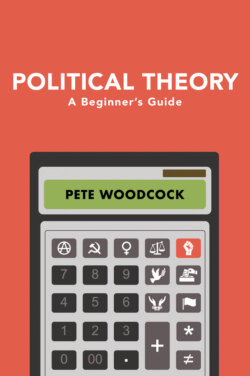Читать книгу Political Theory - Pete Woodcock - Страница 12
How to use this book
ОглавлениеThis book has been organized to be a useful study guide for anyone interested in learning about political theory, be they a school or college student, or an autodidact who wishes to learn the basics on their own. No prior knowledge is assumed on the part of the reader, so the hope is that if the subject interests you, you can just jump straight in. It is a book for everyone, not only for people with substantial existing knowledge on this subject, or for that matter, any other. Perhaps you are studying political theory as part of a course at college or university. Perhaps you have become interested in politics recently, and wish to learn about how some of the central figures of political theory have addressed the issues that you are now grappling with. Or perhaps you simply wish to learn about something new. Whatever your personal learning goal is, my aim in this book is to give you a good solid understanding of the basics of political theory, which you can then build upon perhaps by picking up the primary works of the thinkers discussed within these pages.
Attempts have been made throughout the book to give real-life examples of some of the dilemmas that we address in these pages, and these examples have been chosen with the aim of helping you understand a topic better, and show how the debate contained herein, is applicable to everyday life. Whereas political theory is quite an intellectual pursuit, we should never lose sight of the fact that it should be about real, everyday life; political theory should help us in everyday moral or ethical dilemmas, it should allow us to talk and think politically, and it should aid us in the ability to be good citizens and question political power wherever it may exist. We are not talking about abstract notions here; we are discussing things that happen around us every day.
The book has been organized around key political questions, questions such as ‘what is the nature of the just state?’, and ‘why should I obey the state?’ It is organized in this manner, rather than a thinker-by-thinker structure (i.e. a chapter on Plato, a chapter on Hobbes and so on) to allow you to see the contributions made by various philosophers to similar topics. This structure should better allow you to compare and contrast the thinkers, examine their views on similar topics, and therefore to adopt a critical attitude to their ideas, by showing how they would critique one another.
This book might look slightly different from similar textbooks on the history of political thought. You will not be faced with a wall of text, but rather you might notice some features which are unique to this book. Firstly, each chapter commences with some key questions which you might want to consider before starting the chapter proper. Then within each chapter, you will notice at various points certain keywords or phrases will be emboldened; this is because I feel that these points are crucially important to the discussion in hand. You will also notice small text boxes which give brief summaries of discussions scattered throughout each chapter, and larger text boxes which give you more information on an individual thinker that we are discussing, giving you brief biographical details and the like. You can dip in and out of these sections as best fits your method of learning.
Crucially there are also activities after every section within the book. These activities are designed to solidify your reading, and encourage you to reflect on what you have read. You may choose to do these activities as you read through each chapter, or you may like to do them when you have completed the chapter; it is up to you – do what you feel is best. At the end of each chapter are some text-based questions; these are, perhaps, slightly trickier than the activities contained within each chapter. The text-based activities contain some short excerpts from key texts discussed in the book, with some questions attached. I ask that you read the text, then attempt the questions.
